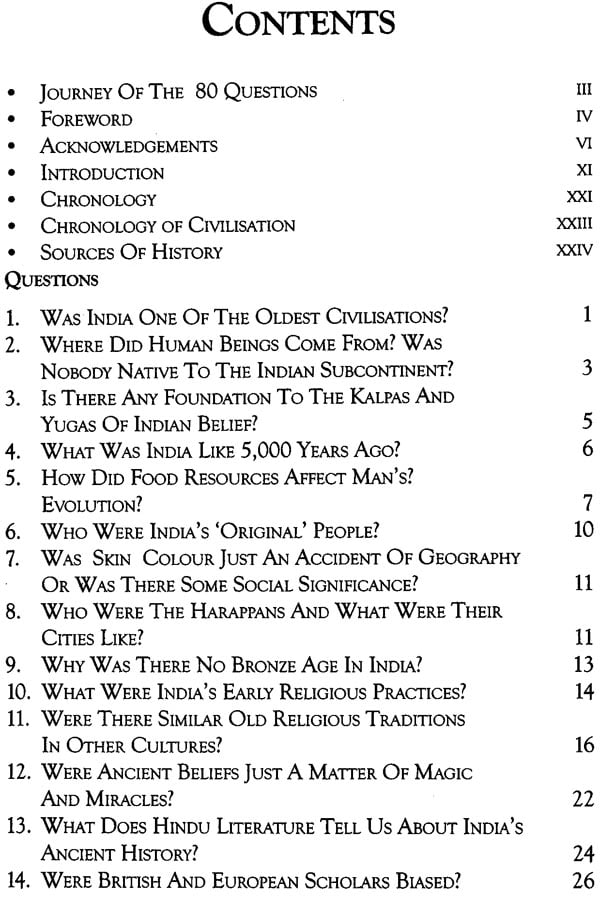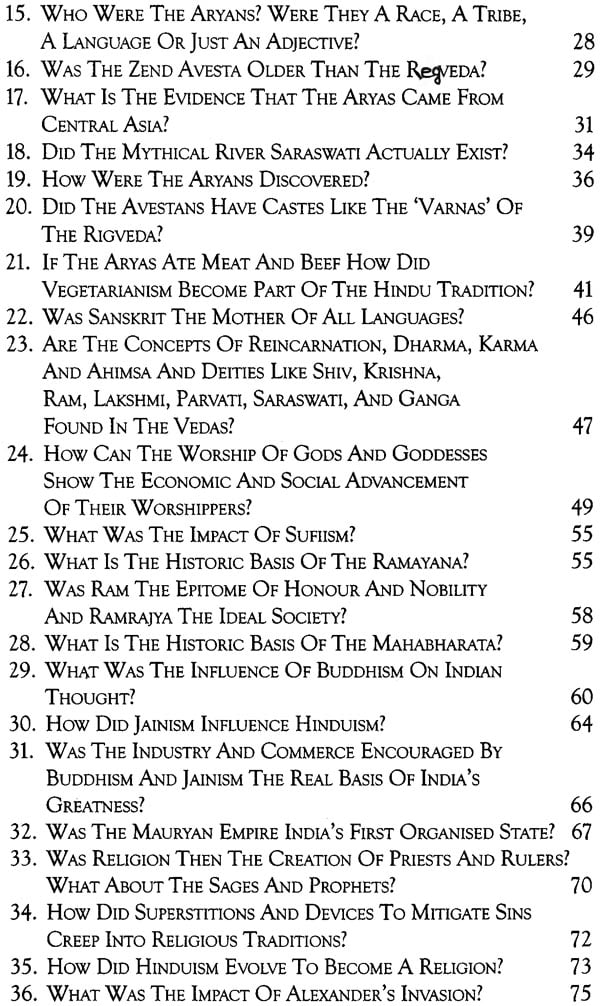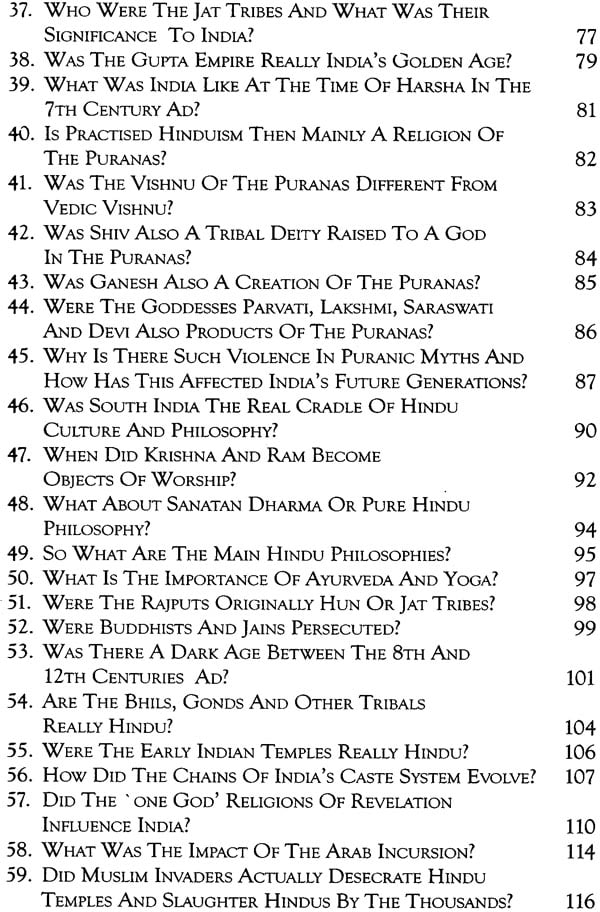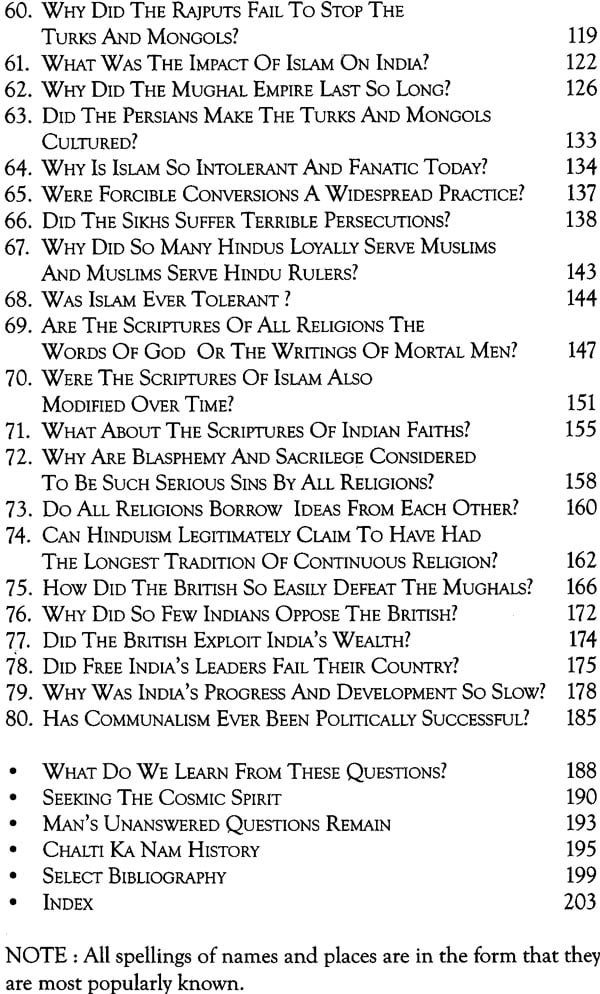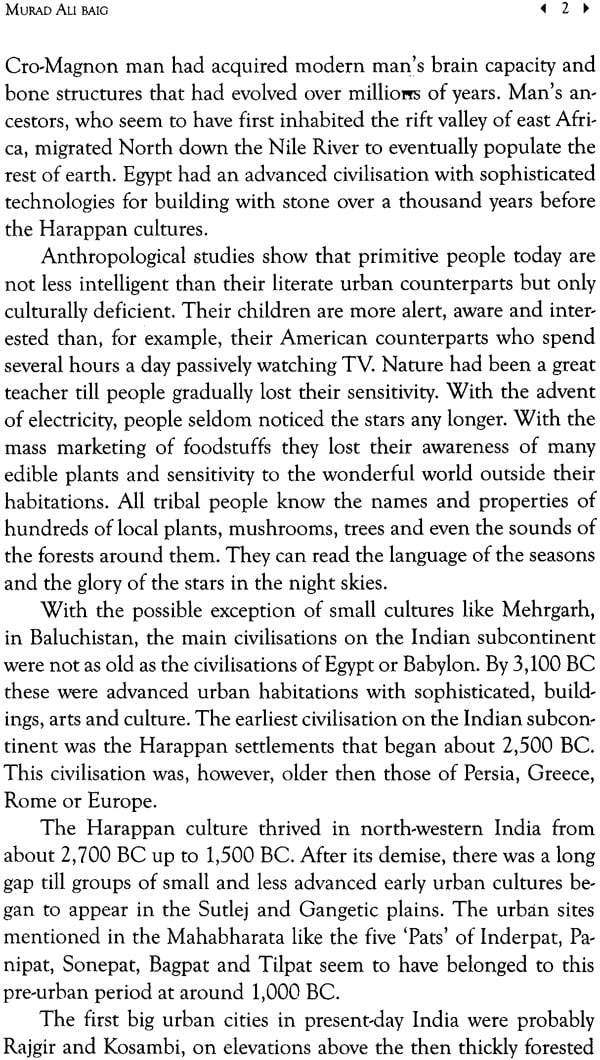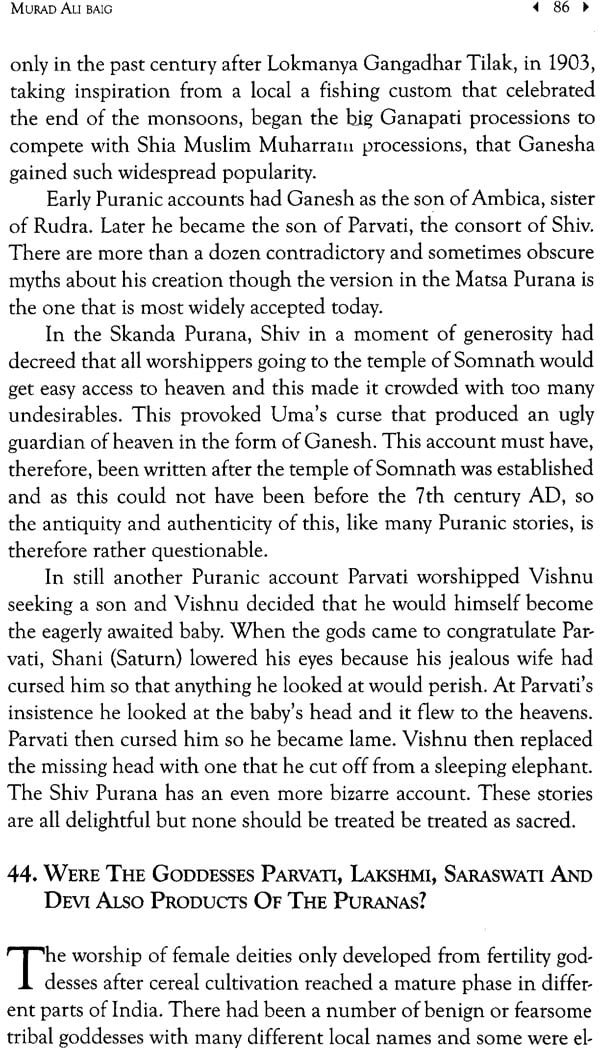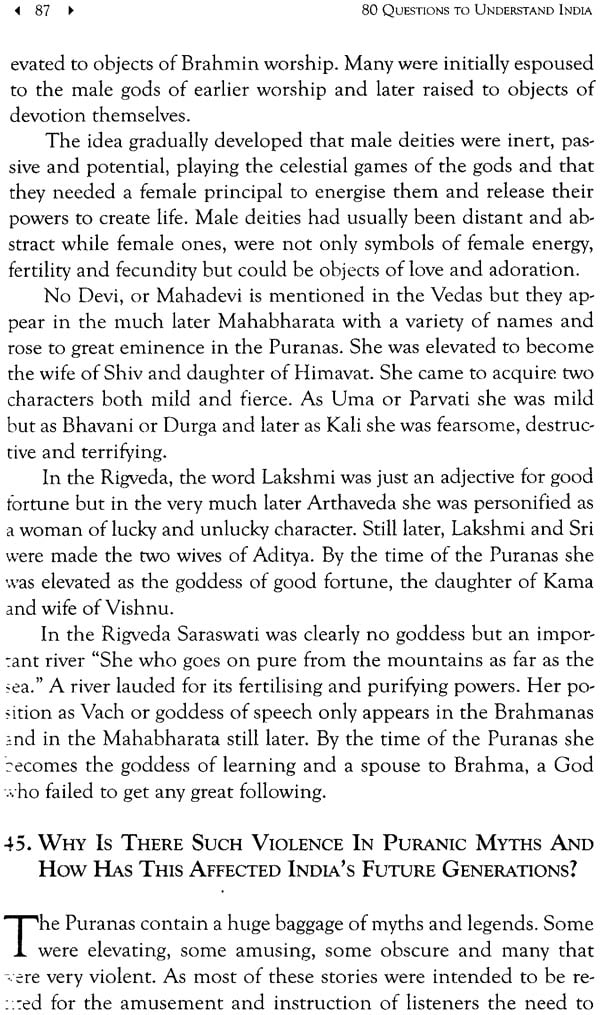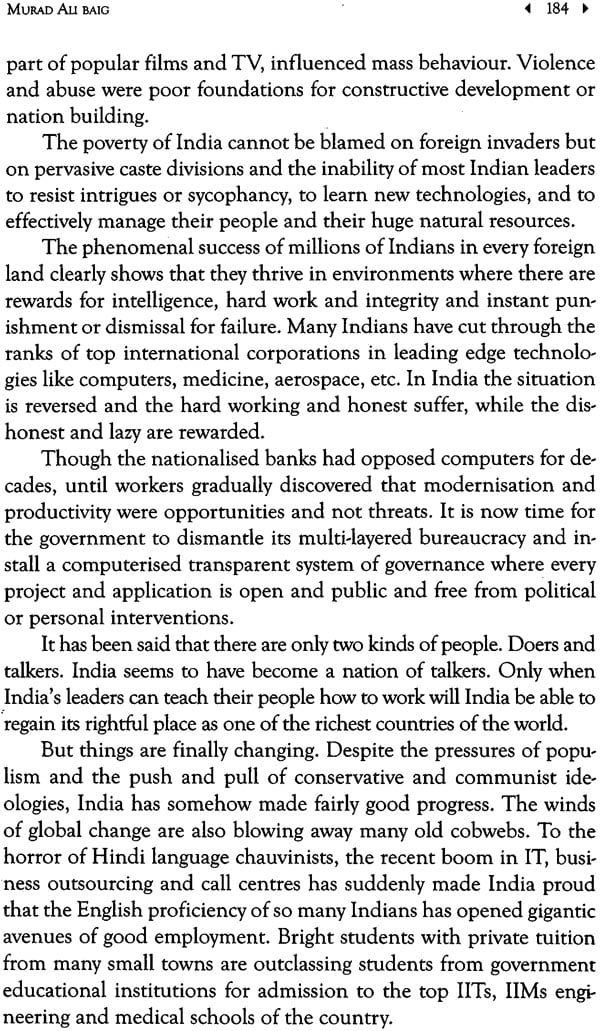
80 Questions to Understand India: History, Mythology and Religion
Book Specification
| Item Code: | NAQ582 |
| Author: | Murad Ali Baig |
| Publisher: | Tara Press, Delhi |
| Language: | English |
| Edition: | 2009 |
| ISBN: | 9788183860932 |
| Pages: | 256 |
| Cover: | HARDCOVER |
| Other Details | 8.50 X 5.50 inch |
| Weight | 400 gm |
Book Description
In this work Murad provides an easy to read and provocative series of questions and answers allowing readers to draw their own conclusions. Writing on religion can be volatile but fortunately he cannot be accused of prejudice when his answers equally affect Hindus, Muslims, Christians, Buddhists, Sikhs and others.
Murad "I read your book from cover to cover and, to put it simply, found it fascinating. it is a powerful condemnation on the sorry state to which all religions have be. brought to because of human interventions. Katrik Narayan
Murad Ali Baig does not question the importance of faith but outlines how all religions have been captured by the vested interests of professional priests claiming to be God's sole selling agents leading to distortions, superstitions and religiosity that the founding sages would have abhorred.
He analyses the five creators of religion: The founding prophets, the apostles, priests, the rulers and the rich as patrons and finally the common people whose offering and sacrifices make the places of worship so rich.
Murad outlines how people the world over have been influenced by geography, sources of food, technological and social change, trade and by political and religious forces. He provides interesting insights into how these have impacted upon the people of India.
In this work Murad provides an easy to read and provocative series of questions and answers allowing readers to draw their own conclusions. Writing on religion can be volatile but fortunately he cannot be accused of prejudice when his answers equally affect Hindus, Muslims, Christians, Buddhists, Sikhs and others.
Murad Ali Baig takes the reader to its past and present, from early society of hunters, nomads and cultivators to more urbane civilized city life, Aryans and their religion, a thousand years of Buddhism, revival of Brahman cal Hinduism, the impact of Islam, the Bhakti movement, the impact of European settlements, the spread of Christianity and changing attitudes towards religions in post-independence India.
Murad Ali Baig may be best known today for his articles on automobiles and travel where he had been editor of the Auto Magazine. He has however also been a prolific writer on widely varied subjects including rural development, power, marketing, humor, history and religion. A product of the Doon School, he did his masters in History from St. Stephens College interrupted by a year at the Sorbonne in Paris, He held senior positions with J. Walter Thompson and Escorts Limited before a career in Public Relations and writing. He has written a book on Barroom Jokes, a book about Rolls Royce and another book The Shape of Cares to Come.
TYRANNY IN SACRED OLOURS
KHUSHWANT SINGH
You must have often wondered why religions, as they are practiced today, are so completely different from what their founders had hoped to make them. The founders had all preached love, understanding and respect for people of other faiths; their followers emphasize their own uniqueness and look down upon and even wage wars against those who do not worship their gods.
Many theories have been propounded to explain the degradation of religion but one of the latest and most perceptive that I have come across is Murad Ali Bag’s 80 Questions (Reflections in a Sacred Pond) which I first saw in an earlier incarnation as Tyranny in Sacred Colors: An Inquiry into the Paradoxes of India's Mythology, Religion and History.
Murad does not question the importance of faith but outlines how religions have been altered by the vested interests of the professional priests of all religions and especially outlines its impact on India. He outlines how distortions, religiosity and superstitions that crept into all religions especially in Hinduism, Islam, Jainism, Buddhism and Sikhism as are practiced in India.
He analyses the five participants in the practice of religion: the founder prophets, apostles, priests, rulers and the rich who became the patrons of religion and finally the common people who were persuaded to make offerings and sacrifices to insure themselves against the uncertainties of the future in life and the afterlife.
Murad takes the reader on a fast Bharat Darshan tour from its hoary past to the present, from the early societies of hunters, nomads and cultivators to more urbane civilized city life, the Aryans and their religion, a thousand years of Buddhism, revival of Brahe- maniacal Hinduism, the impact of Islam, the Bhakti movement, the impact of Europeans and the spread of Cistianity as well as the attitudes towards religion in post-indepencrence India.
In this bewildering change of scenes one thing comes clear: in order to preserve their separate identity and assert their superiority over other faiths, the preachers of all religions understood that hate is a much stronger emotion than love. They practiced it in the past: they practice it today.
In this work, Murad has changed the format from a series of statements to a Question and Answer format where readers can draw their own conclusions based on the evidence that he has pro-vided. I suspect that caution has led him to this as writings on religion are always highly volatile and words attributed to him are bound to produce reactions. Fortunately, it is the questions that are provocative and he cannot be accused of bias when his answers equally affect Hindus, Muslims, Christians, Buddhists, Sikhs and others.
The answer to his last question is perhaps the most important for it shows how communalism has never been very successful politically despite the huge passions generated by religious and racial fanaticism.
Few people realize that it is mythology that is the joker which has consistently distorted both history and religion in every country. The development of these myths and legends into scripture and history is actually easy to understand. Once upon a time, before there were films and TV, people in small towns and villages all over the world were entertained by wandering storytellers, min-strels and holy men with amazing tales of great heroes, beautiful heroines, awesome villains, terrifying demons and invincible divine forces. Not surprisingly, many small actual historic events would become magnified with each retelling to evolve into great legends. But myths are to a people what dreams are to individuals - colour-ful, fanciful and usually harmless outlets for the hopes, dreams, fantasies, angers and frustrations of their daily lives.
Over the years, these tales of victory, defeat, joy or sorrow were elaborated into theatrical events at celebrations of Holi, Dusseh-era, Eid, Muharram, Christmas, Easter, and the festivals of every land. So infectious and entertaining were these celebrations that the priests of all faiths were only too happy to weave these simple tales, as parables for the enlightenment of the people, into their scriptures as they evolved. So all scriptures, written long after the deaths of their founders, contain a huge baggage of mythology and customs that came to acquire almost the same sacred status as their core philosophies.
But when some priests declared that these myths were to be dogma, they created a body of inflexible tradition that separated their followers from the followers of other faiths. No prophet or founder prescribed any such dogma but dogma was to become divisive and created discord and conflict between religions and even between sects within the same religions. All the prophets were, in fact, rebels against earlier dogma and had been declared as heretics. Clerics forget that yesterday's heretics were to become the founders of new faiths. Buddha, Zoroaster, Jesus, Muhammad, Luther, Nanak and many others had all been branded as heretics by priests of older orders. Later their own followers were to declarer words as the final wisdom and call all new dissenters heretics.
Three hundred years ago, no one considered themselves Indian but as races like the Mughals, Afghans or Rajputs; castes like Brah-mins, Kshatriyas, Vaishyas, Shudras, Banias, Chamars or linguistic groups like Bengalis, Marathas, Andhras, Tamils, etc. Geographic boundaries were fluid and the people of the Indian subcontinent were willingly subservient and loyal to their Mughal and later their British rulers. There were so many different identities that they had little sense of nation.
Three hundred years ago very few people considered them-selves Hindu, as this word only vaguely existed. They considered themselves as Vaishnavas, Shaivites, Rambhaktas, Kabirpanthis and worshippers of Kali, Devis and numerous tribal deities.
It was only in 1826 that Raja Ram Mohan Roy used the originally Persian word Hindu as a unifying label to embrace all the varied forms of indigenous worship. Later Dayanand Saraswati, Vi-vekananda, Radhakrishnan and other reformers and philosophers gave the concept further shape and sincerely tried to integrate the many diverse faiths into a religion similar to the religions of revela-tion such as Islam and Christianity. Indian political leaders also wanted an equally distinct and well-defined Hindu religion know-ing that religion had great political potential.
The so-called sanctity of religion made all those in political or administrative authority very careful in dealing with all religious practices that perhaps explains how tolerant police or other author-ities are to the contravention of laws, rules or human rights as long as these are done in the name of religion.
This book evolved from a short essay called 'India Unvarnished' that I first wrote in 1991 in a furious four days after listening to the strong but ardent opinions of one of my Hindutva friends. A good friend, even if one who was deeply steeped in a rather romantic ver-sion of India's past that did not quite accord with what I had learned of history that had been my subject in college and a passion in lat-err life. It is however paradoxical that much of the Hindutva vitriol against Muslims is owed to the highly egerated accounts by Muslim chroniclers, who in the Persian style of flowery prose, would pen words of lavish praise or condemnation. Many British historians also relied on these for their accounts of mediaeval India. These eulogies flattering the brutality or even the piety of Mahmud Ghazni, Alaud-din Khilji, Aurangzeb and others are therefore very dubious. Sadly this love for exaggerated praise or condemnation continues to the present day leading to excessive hype as is evident even in the report-ing on politics, film stars and even cricket.
These questions become all the more pertinent when a stormy controversy broke out after the demolition of the Babri Masjid in 1992. Many serious historians objected to the efforts of some scholars with clear Hindu Parishad leanings who were attempting to delete or rewrite portions of India's history textbooks that did not accord with their vision of India's glorious Hindu past.
A few dozen copies of the essay circulated to friends soon generated generous bouquets and furious brickbats showing that the issues selected were subjects of intense interest especially to anyone on the Indian subcontinent. Many emotive issues clearly needed to be studied dispassionately especially as such prejudices based on mythical or romanticized facts breed hurtful prejudices and destructive anger.
When my friend Aswan Shah put the 2001 version of the evolving essay up on his website it attracted hundreds of responses from all over the world. Despite a severe mauling by some, the many intelligent and detailed responses helped me to correct several mistakes and omissions and add many useful additional ideas and in-formation.
Many critics also felt that my questions and answers were bi-asked. Fortunately I was equally accused of bias against Hindus, Muslims, Christians, Sikhs and others so these criticisms roughly cancelled out. Others observed that the text was too simplistic, half-cooked and that I had provided no original research. I, therefore, need to say that I have not tried to present a complete record of all the historical facts about India, as to attempt that would require many thousands of pages. The purpose of this book is to stimulate interest so that readers can do their own explorations.
Book's Contents and Sample Pages
